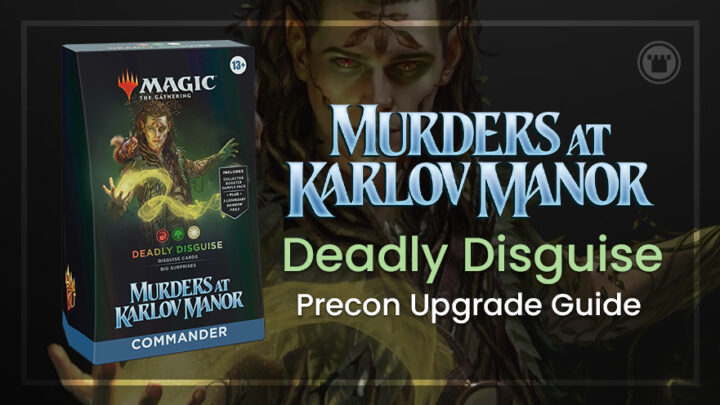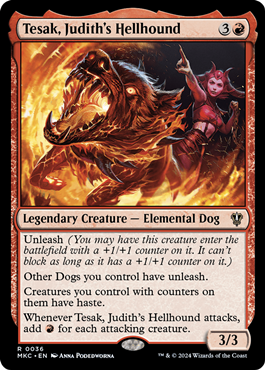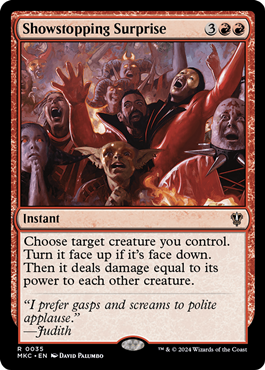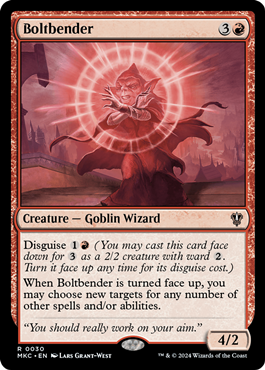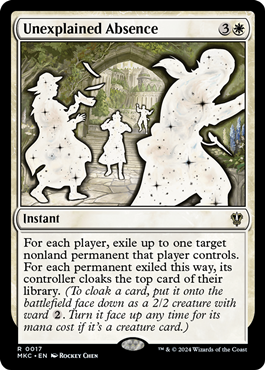Murder mysteries and vast, magic-soaked cityscapes are two great tastes that go great together, which is why the Murders at Karlov Manor Commander precons explore how different tropes from the whodunit and film noir genres fit into the beloved setting of Ravnica. And while Deadly Disguise is all about playing cards face-down to obscure your true plans, our upgrade guide is here to make them even deadlier.
Since all your face-down cards count as identical 2/2 creatures, your opponents will have no way to know what’s actually in play until it’s too late. Pay their disguise cost to flip your creatures face up in the middle of combat or to trap your foes with powerful triggered abilities. Even the most quick-witted detectives will struggle to keep up with the combination of bluff and brawn brought to bear by the druidic deceivers we’re about to discover in this deck!
Meet the Commanders
The default commander for Deadly Disguise is a dryad detective from the Ravnican Agency of Magicological Investigations.
Most law enforcement in Ravnica is provided by the Boros and Azorius guilds, but their power does not reach the plane’s isolated, abandoned patches of nature. To any non-native investigators, Kaust’s beat is a confusing and deadly jungle. They see only vague shapes rustling behind the leaves, which is represented in game by the disguise mechanic, letting all sorts of creatures sneak up on opponents.
Playing a creature face-down always costs three, so disguised creatures with high casting costs usually require a lot of extra mana to turn face up. But the Eyes of the Glade lets you bypass that cost so long as your disguised creature is attacking. This means you can potentially use disguise as an unorthodox form of mana ramp!
In addition to cheating out big creatures and confusing opponents, Kaust also rewards you with free cards every time you successfully connect with a freshly-revealed creature, which really sets a clear blueprint for how this precon is going to play.
As only a 2/2 himself, he’s definitely more an enabler than the star of the show. But that tends to be the kind of commander you need to specialize in a niche mechanic like this — and for just two mana, you can reliably ensure he will be around whenever you need something enabled.
There’s only one other legend in this deck which has the right color identity to easily swap into the command zone, and she takes a very different approach to enhancing your disguise gameplan.
All face-down cards on the battlefield are considered 2/2 creatures, whether they were put there by disguise, cloak, or any previous mechanic. Creatures with that power-toughness combination have been fondly referred to as “bears” ever since Grizzly Bears set the precedent back in Alpha. Most of Magic’s subsequent bears have also been printed as 2/2s for two mana, keeping the association strong.
So we arrive at Duskana, the Rage Mother: a legendary bear who buffs not only literal bears, but also any figurative bears which share their base stats — even if only temporarily! Her ETB will reliably draw a lot of cards combined with disguise (or with a lot of ordinary token generators), while her triggered ability ensures all your bears will grow up big and strong like their mama.
A horde of 5/5s is already scary for most opponents, but the trick here is that you only need a creature to be 2/2 during the Declare Attackers step for it to get the buff. You can then turn it face-up or slam any other buffs onto it mid-combat and still retain the +3/+3 from Duskana for maximum value.
While she costs more than twice as much as Kaust, this attack trigger gives Duskana the potential for game-changing impact from the first turn she hits play. Even if opponents sacrifice their momentum to hold up mana and instantly remove her, you’re likely to be drawing multiple cards from her ETB from every cast.
It’s a frightening equation for the table no matter how you square it, and the Rage Mother looks like a perfectly viable commander for both the Deadly Disguise precon and more traditional bear-themed decks.
Precon Review
While Murders at Karlov Manor is not the first time we’ve seen mechanical support for face-down cards, it’s still a relatively rare theme — especially in these colors.
As such, the new cards printed in Deadly Disguise will be priceless additions for a small handful of players who have been patiently waiting for this kind of product to appear. For everyone else, their value will depend more on the general utility and efficiency of their effect rather than the highly specific hoops you’re jumping through to get there.
One example of a generically useful card is Tesak, Judith’s Hellhound. There’s a lot of diverse options you could explore with this puppy as your commander thanks to its diverse synergies with dogs, +1/+1 counters and even elementals.
The pup also slots into red’s ever-growing arsenal of cards that easily convert combat steps into bonus mana. This can lead to infinite combos with Hellkite Charger and Aggravated Assault, or allow commanders like Flamewar or Amber Gristle O’Maul to “storm off” with repeated extra combat spells!
Showstopping Surprise almost seems like it will be more useful in other kinds of decks — particularly the kind that play few creatures other than their commander. Blowing up the majority of your attack force is a serious setback for Deadly Disguise, but as an instant-speed sweeper you can sometimes finesse to leave your largest things alive, it’s still worth serious consideration here.
I’m always a fan of red and black getting more defensive interaction, and while Boltbender isn’t anything new to red’s color pie, it’s still a potent effect in an efficient package. You don’t necessarily need any other disguise creatures to make Boltbender effective. Just getting to hold up the ability is great even when your opponents know what’s coming.
Unexplained Absence is a little expensive as interaction goes, but you do get some huge impact for your mana outlay with high potential upside. Ideally you’re able to “upgrade” the worst thing you have in play with the cloak trigger while downgrading each opponent’s best threat. If you happen to have any synergies with facedown creatures or cards, then that ideal scenario starts to seem actually pretty realistic.
$50 Upgrade Guide
Whenever I start modifying a precon, I like to firmly establish how our deck is trying to play and the game plan we’re aiming to achieve. For the stock Deadly Disguise decklist that’s very clear: we’re trying to play more and bigger creatures than everyone else and then attack our enemies to death.
Without a specific combo to play toward, all the face-down trickery is either generating value to help us dominate the board or providing some instant speed utility so we aren’t complete, sitting ducks for every blue player at the table.
We might aim to change that in our upgrade (adding an actual combo kill sounds like a reasonable Plan B), but it’s cheaper to go with the existing flow of the deck than to try and fully rebuild it into something else.
Now that we know the game plan, we can identify any cards that seem superfluous or in conflict with that plan and cut them to make room for the first upgrade cards. In this case, I’m being very suspicious of any non-creature (and especially non-permanent) spells that don’t strongly synergise with our core mechanics. There’s enough “whenever you turn a creature face-up” triggers here that I want to minimize how often our manifest and cloak effects can “miss” and leave us with inert 2/2s!
I do also want to make a few more cuts by thinning out any expensive morph creatures that lack useful abilities beyond raw combat stats. While Kaust can get some sneaky value from playing these ahead of curve, I don’t find that alone enough to justify their limited potential in multiplayer commander.
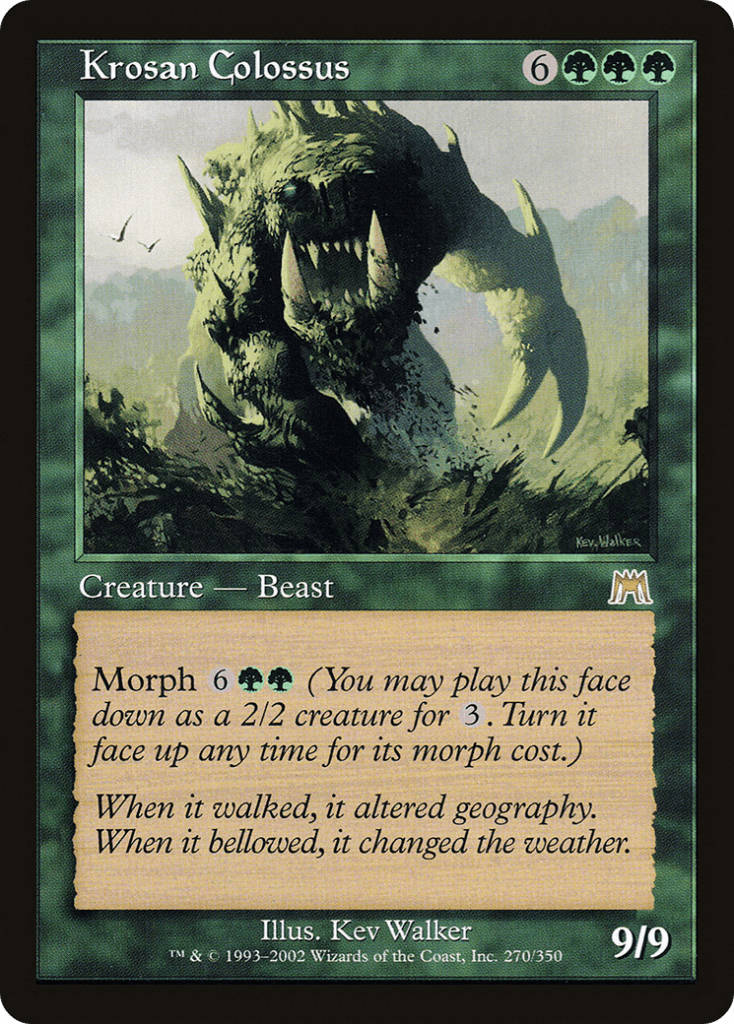
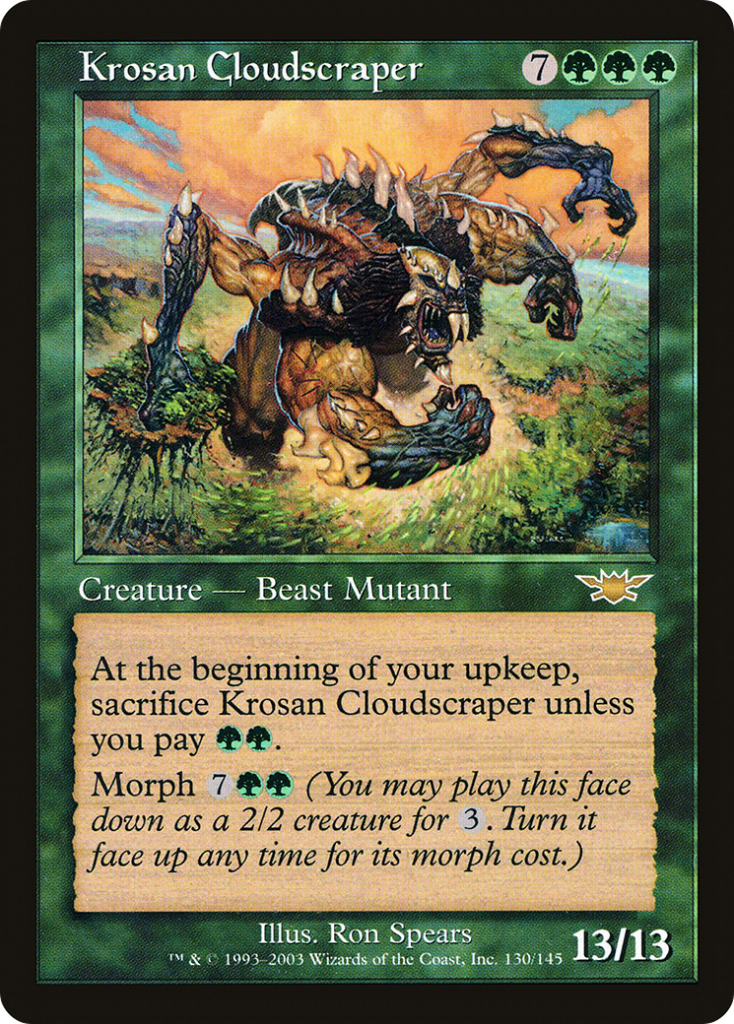
When it comes to adding cards to a deck with very specific themes, the goal is just to maximize synergy with what’s already there. Anything that reduces the generic mana costs of creature spells or triggers upon casting one can work extremely well with disguise or morph cards, since they always cost three mana to cast.
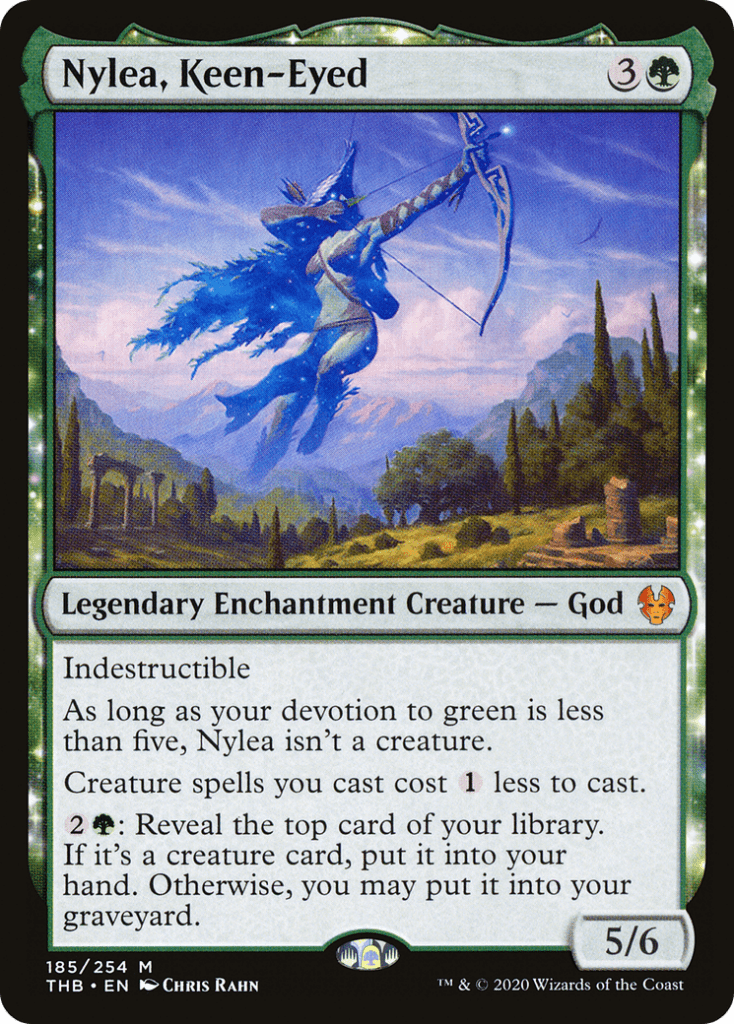
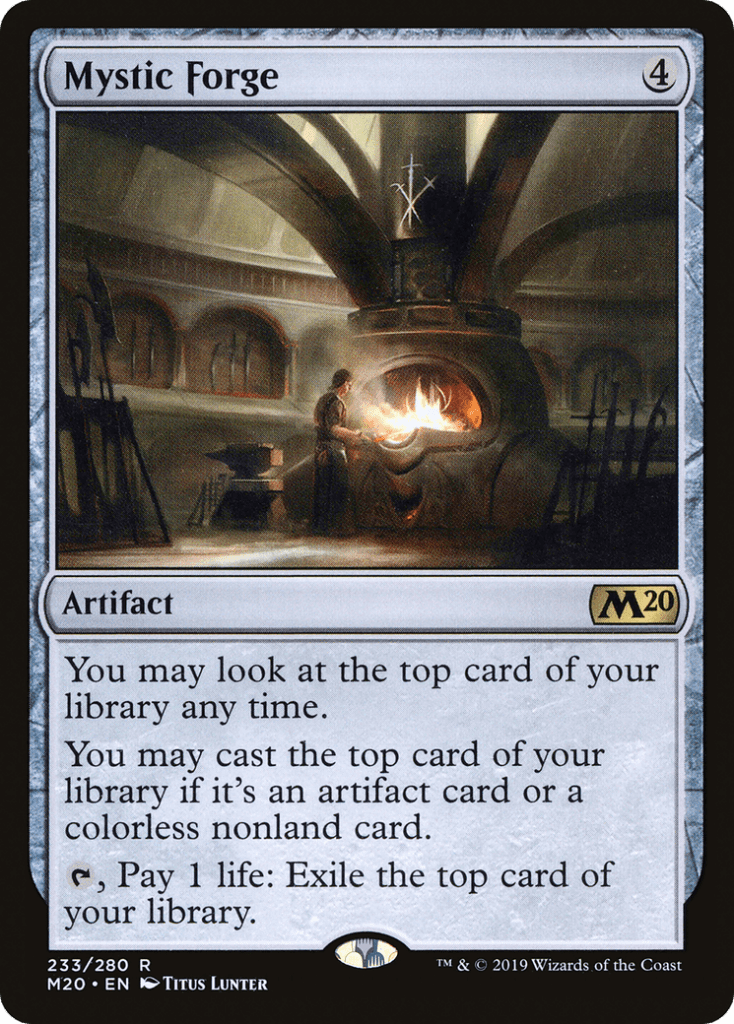
Flickering and bouncing our own creatures are other ways to bypass disguise costs or re-use “turn face-up” effects. Flickering a face-down card doesn’t count as turning it face-up for the sake of triggers, but it does let us “rescue” any noncreature permanent that gets stuck as a 2/2 through cloak or manifest.
Most cards which reward playing or attacking with small creatures can also be beneficial to our deck, so long as we don’t lose too much for them becoming bigger afterwards.
After getting through our cuts and additions, here’s the $50 upgrade package integrated into the Deadly Disguise precon.
A Kaustian Bargain
I was a little surprised when the disguise and cloak mechanics turned out to be so close to morph and manifest. While the gameplay of face-down cards is always extremely memorable and fun in Limited, their mana-intensive setup and complex rules seemed to belong to a long-past era of Magic design.
Credit to Wizards of the Coast, though. They knew what they wanted for the murder-mystery set — and the result is this highly unique and exciting precon. Kaust is one of the best niche-mechanic commanders I’ve seen in a while. He gives you the confidence to play more disguise and morph creatures and unlocks some new tricks with them, but not in a way that overshadows their actual designs.
One advantage of building around a very narrow theme is the cards you want tend to stay affordable. So if you do decide to pick up your own Deadly Disguise precon, remember that $50 can take it a long way!

Tom’s fate was sealed in 7th grade when his friend lent him a pile of commons to play Magic. He quickly picked up Boros and Orzhov decks in Ravnica block and has remained a staunch white magician ever since. A fan of all Constructed formats, he enjoys studying the history of the tournament meta. He specializes in midrange decks, especially Death & Taxes and Martyr Proc. One day, he swears he will win an MCQ with Evershrike. Ask him how at @AWanderingBard, or watch him stream Magic at twitch.tv/TheWanderingBard.

